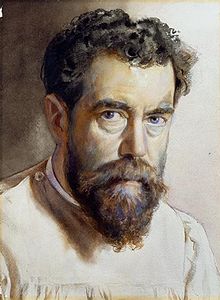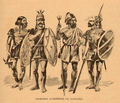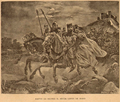Alfredo Roque Gameiro: Difference between revisions
m Copying from Category:19th-century Portuguese painters to Category:19th-century male artists using Cat-a-lot |
m Copying from Category:19th-century Portuguese painters to Category:19th-century Portuguese male artists Diffusing per WP:DIFFUSE and/or WP:ALLINCLUDED using Cat-a-lot |
||
| (45 intermediate revisions by 20 users not shown) | |||
| Line 1: | Line 1: | ||
{{Short description|Portuguese painter (1864–1935)}} |
|||
[[File:Alfredo roque gameiro auto-retrato.jpg|thumb|200px|Self-portrait (1910s)]] |
|||
{{Infobox artist |
|||
| ⚫ | |||
| honorific_prefix = |
|||
| name = Alfredo Roque Gameiro |
|||
| honorific_suffix = |
|||
| image = Alfredo roque gameiro auto-retrato.jpg |
|||
| image_size = |
|||
| caption = ''Self-portrait'' (1910s), by Veloso Salgado<br>[[José Malhoa Museum]], [[Caldas da Rainha]] |
|||
| birth_date = April 4, 1864 |
|||
| birth_place = [[Alcanena]], [[Minde (Alcanena)|Minde]], [[Portugal]] |
|||
| death_date = August 5, 1935 |
|||
| death_place = [[Lisbon]], [[Portugal]] |
|||
| resting_place = |
|||
| nationality = [[Portugal|Portuguese]] |
|||
| residence = |
|||
| education = |
|||
| alma_mater = |
|||
| known_for = |
|||
| notable_works = |
|||
| style = |
|||
| movement = |
|||
| spouse = |
|||
| awards = |
|||
| patrons = |
|||
| memorials = |
|||
| module = |
|||
}} |
|||
| ⚫ | |||
== Biography == |
== Biography == |
||
[[File:Frontispiece of "História da Colonização Portuguesa do Brasil", illustrated by Roque Gameiro, 1921.jpg|thumb|Frontispiece of "História da Colonização Portuguesa do Brasil", illustrated by Roque Gameiro, 1921]] |
|||
| ⚫ | When he was ten years old, he went to live in Lisbon with his oldest brother, Justin, who owned a [[lithography]] studio.<ref name="A">[http://aarteemportugal.blogspot.com/2014/10/alfredo-roque-gameiro-1864-1935.html Brief biography] @ A Arte em Portugal.</ref> He studied at the "Faculty of Fine Arts" of the [[University of Lisbon]], where {{ill|José Simões de Almeida|pt|José Simões de Almeida (Tio)}} was one of his professors. |
||
| ⚫ | |||
| ⚫ | Alfredo Roque Gameiro was born in [[Minde, Portugal]]. When he was ten years old, he went to live in Lisbon with his oldest brother, Justin, who owned a [[lithography]] studio.<ref name="A">[http://aarteemportugal.blogspot.com/2014/10/alfredo-roque-gameiro-1864-1935.html Brief biography] @ A Arte em Portugal.</ref> He studied at the "Faculty of Fine Arts" of the [[University of Lisbon]], where {{ill|José Simões de Almeida (tio)|lt=José Simões de Almeida|pt|José Simões de Almeida (Tio)}} was one of his professors. |
||
After receiving a scholarship from the Portuguese government, he attended the "[[Hochschule für Grafik und Buchkunst Leipzig|Hochschule für Grafik und Buchkunst]]" in Leipzig and studied lithography with Ludwig Nieper (1826-1906).<ref name="A" /> Upon returning to Portugal in 1886, he became the Director of the "Companhia Nacional Editora" and, in 1894, was appointed a Professor at the "Escola Industrial do Príncipe Real". |
After receiving a scholarship from the Portuguese government, he attended the "[[Hochschule für Grafik und Buchkunst Leipzig|Hochschule für Grafik und Buchkunst]]" in Leipzig and studied lithography with Ludwig Nieper (1826-1906).<ref name="A" /> Upon returning to Portugal in 1886, he became the Director of the "Companhia Nacional Editora" and, in 1894, was appointed a Professor at the "Escola Industrial do Príncipe Real". |
||
He was a frequent contributor to several weekly and monthly periodicals and worked with Manuel de Macedo (1839-1915) to provide illustrations for a deluxe edition of ''[[The Lusiads]]'', published in 1900. From 1910 to 1920 he created 10 watercolors and 90 lithographs for what would be his most popular work, ''Lisboa Velha'' (Old Lisbon), with an introduction by the poet {{ill|Afonso Lopes Vieira|pt}}. He also illustrated several popular novels by [[Júlio Dinis]]. In 1919, he became the first Director of the "Escola de Arte Aplicada de Lisboa", a position he held until 1930. The following year, he and his daughter Helena had a successful joint exhibition in Brazil. He was elected a member of the [[Real Academia de Bellas Artes de San Fernando]] in 1923. |
He was a frequent contributor to several weekly and monthly periodicals and worked with Manuel de Macedo (1839-1915) to provide illustrations for a deluxe edition of ''[[The Lusiads]]'', published in 1900. From 1910 to 1920 he created 10 watercolors and 90 lithographs for what would be his most popular work, ''Lisboa Velha'' (Old Lisbon), with an introduction by the poet {{ill|Afonso Lopes Vieira|pt}}. He also illustrated several popular novels by [[Júlio Dinis]]. In 1919, he became the first Director of the "Escola de Arte Aplicada de Lisboa", a position he held until 1930. The following year, he and his daughter Helena had a successful joint exhibition in Brazil. He was elected a member of the [[Real Academia de Bellas Artes de San Fernando]] in 1923. |
||
| ⚫ | |||
| ⚫ | Three institutions bear his name: the "Escola Roque Gameiro" in [[Amadora]] (where he lived for many years), the "Casa Roque Gameiro" (his home, partly designed by [[Raul Lino]]; now an exhibition space) and the "Centro de Artes e Ofícios Roque Gameiro" in his hometown, which includes a museum devoted to watercolors. A majority of his works are on display at the municipal museum there, including many on loan from the [[Gulbenkian Foundation]]. Some of his designs appear on Portuguese postage stamps. |
||
| ⚫ | Three institutions bear his name: the "Escola Roque Gameiro" in [[Amadora]] (where he lived for many years), the "Casa Roque Gameiro" (his home, partly designed by [[Raul Lino]]; now an exhibition space) and the "Centro de Artes e Ofícios Roque Gameiro" in his hometown, which includes a museum devoted to watercolors. A majority of his works are on display at the municipal museum there, including many on loan from the [[Gulbenkian Foundation]]. Some of his designs appear on Portuguese postage stamps. |
||
All five of his children became artists: |
All five of his children became artists: |
||
<ref>[http://luiscabral.org/art/arg/family Luís Cabral] ''A family of artists''</ref> |
<ref>[http://luiscabral.org/art/arg/family Luís Cabral] ''A family of artists''</ref> |
||
*[[Raquel Roque Gameiro Ottolini]] (1889-1970), also a watercolorist, |
*[[Raquel Roque Gameiro Ottolini]] (1889-1970), also a watercolorist, |
||
*{{ill|Manuel Roque Gameiro|pt}} (1890-1944), who worked with diverse materials |
*{{ill|Manuel Roque Gameiro|pt}} (1890-1944), who worked with diverse materials. |
||
*[[Helena Roque Gameiro]] (1895-1986), a landscape painter who married the film director [[José Leitão de Barros]], |
*[[Helena Roque Gameiro]] (1895-1986), a landscape painter who married the film director [[José Leitão de Barros]], |
||
*{{ill|Maria Emília (Màmia) Roque Gameiro|pt}} (1901-1996), oil and watercolor painter; married to painter [[Jaime Martins Barata]] |
*{{ill|Maria Emília (Màmia) Roque Gameiro|pt}} (1901-1996), oil and watercolor painter; married to painter [[Jaime Martins Barata]] |
||
*[[Ruy Roque Gameiro]] (1907-1935), a sculptor who, despite his short life, is the best-known. His sculptures may be seen in Portugal and [[Mozambique]]. |
*[[Ruy Roque Gameiro]] (1907-1935), a sculptor who, despite his short life, is the best-known. His sculptures may be seen in Portugal and [[Mozambique]]. |
||
==Works== |
|||
| ⚫ | |||
===''Quadros da História de Portugal''=== |
|||
<gallery> |
|||
File:Romanos e Lusitanos (Roque Gameiro, Quadros da História de Portugal, 1917).png|"Romans and Lusitanians" |
|||
File:Cavaleiro Medieval (Roque Gameiro, Quadros da História de Portugal, 1917).png|"Medieval knight" |
|||
File:Conquista de Lisboa (Roque Gameiro, Quadros da História de Portugal, 1917).png|"Conquest of Lisbon" |
|||
File:Tomada de Santarém (Roque Gameiro, Quadros da História de Portugal, 1917).png|"The Taking of Santarém" |
|||
File:Sala Mourisca em Sintra (Roque Gameiro, Quadros da História de Portugal, 1917).png|"Moorish Room in Sintra" |
|||
File:Leonor Telles deante do cadaver do conde de Andeiro (cropped).png|"Leonor Telles Before the Corpse of the Count Andeiro" |
|||
File:Egas Moniz em Leão (Roque Gameiro, Quadros da História de Portugal, 1917).png|"Egas Moniz in Leon" |
|||
File:D. Pedro Castiga o Bispo do Porto (Roque Gameiro, Quadros da História de Portugal, 1917).png|"Dom Pedro Punishes the Bishop of Porto" |
|||
File:D. João II Examina a Construção das Naus (Roque Gameiro, Quadros da História de Portugal, 1917).png|"John II inspects the Construction of the Naus" |
|||
File:Padrão Erguido pelos Portugueses na Foz do Zaire (Roque Gameiro, Quadros da História de Portugal, 1917).png|"Marker raised by the Portuguese by the Mouth of the River Zaire" |
|||
File:A partida de Vasco da Gama para a Índia em 1497.jpg|"Departure of Vasco da Gama to India" |
|||
File:O povo amotinado precipita o cadáver do bispo D. Martinho da torre da Sé (Roque Gameiro, in Leonor Telles, por Marcelino Mesquita, 1904).png|"The People Throw the Body of the Bishop Dom Martinho from the Tower of the Cathedral in a Mutiny" |
|||
File:Distúrbios de Afonso VI em Lisboa (Roque Gameiro, Quadros da História de Portugal, 1917).png|"Disturbances of Afonso VI in Lisbon" |
|||
File:Os Franceses na Primeira Invasão (Roque Gameiro, Quadros da História de Portugal, 1917).png|"The French in the First Invasion" |
|||
File:Desembarque dos Liberais no Mindelo em 1832 (Roque Gameiro, Quadros da História de Portugal, 1917).png|"Landing of the Liberals in Porto" |
|||
</gallery> |
|||
===''Lisboa Velha'', 1925=== |
|||
| ⚫ | |||
<gallery> |
|||
File:Roque Gameiro (Lisboa Velha, n.º 96) Chafariz da Alegria.png|"Chafariz da Alegria" |
|||
File:Roque Gameiro (Lisboa Velha, n.º 36) Rua das Madres 1.png|"Rua das Madres" |
|||
File:Roque Gameiro (Lisboa Velha, n.º 43) Entrada da Rua de S. Miguel (Alfama).png|"Entrada da Rua de S. Miguel" |
|||
File:Roque Gameiro (Lisboa Velha, n.º 27) O Arco Escuro 1.png|"O Arco Escuro" |
|||
File:Roque Gameiro (Lisboa Velha, n.º 12) Rua do Vieira Portuense (Belém).png|"Vieira Portuense Street" |
|||
</gallery> |
|||
===''História de Portugal Popular e Ilustrada''=== |
|||
<gallery> |
|||
File:História de Portugal, popular e ilustrada (Manuel Pinheiro Chagas, 1899-1905).png|"Popular History of Portugal Illustrated" |
|||
File:Primeiros guerreiros da Lusitania - História de Portugal, popular e ilustrada.png|"First Warriors of Lusitania" |
|||
File:D. Pedro I açoitando o Bispo do Porto - História de Portugal, popular e ilustrada.png|"Dom Pedro Whipping the Bishop of Porto" |
|||
File:Prisão do Mestre de Avis - História de Portugal, popular e ilustrada.png|"Imprisonment of the Master of Aviz" |
|||
File:Batalha do Salado - História de Portugal, popular e ilustrada.png|"Battle of Salado" |
|||
File:Rapto da Rainha D. Mécia Lopes de Haro - História de Portugal, popular e ilustrada.png|"Kidnap of the Queen Dona Mécia Lopes de Haro" |
|||
File:Entrevista de D. Leonor Teles com seu genro - História de Portugal, popular e ilustrada.png|"Interview of Dona Leonor Teles" |
|||
File:A lenda do Alfageme de Santarém - História de Portugal, popular e ilustrada.png|"The Legend of the Alfageme of Santarém" |
|||
File:Martim de Freitas depositando as chaves do Castelo de Coimbra nas mãos do cadáver de D. Sancho II - História de Portugal, popular e ilustrada.png|"Martim de Freitas Depositing the Keys to the Castle of Coimbra in the Hands of the Corpse of King Dom Sancho II" |
|||
File:Tomada de Évora, Geraldo-Sem-Pavor assaltando a torre da Atalaia - História de Portugal, popular e ilustrada.png|"Taking of Évora, Geraldo the Fearless Storming the Keep". |
|||
File:Morte do Bispo de Lisboa - História de Portugal, popular e ilustrada.png|"Death of the Bishop of Lisbon" |
|||
File:Assassínio da Abadessa do Mosteiro de S. Bento, em Évora - História de Portugal, popular e ilustrada.png|"Death of the Abadess of the Monastery of Saint Benedict in Évora" |
|||
File:Morte do lidador Gonçalo Mendes da Maia - História de Portugal, popular e ilustrada.png|"Death of Gonçalo Mendes da Maia" |
|||
File:O assassínio de Lançarote Pessanha - História de Portugal, popular e ilustrada.png|"Murder of Lançarote Pessanha" |
|||
File:Combate naval no porto de Saltes - História de Portugal, popular e ilustrada.png|"Naval Combat in the Harbour of Saltes" |
|||
File:Batalha de Zalaka - História de Portugal, popular e ilustrada.png|"Battle of Zalaca" |
|||
</gallery> |
|||
==References== |
==References== |
||
| Line 43: | Line 126: | ||
[[Category:Portuguese illustrators]] |
[[Category:Portuguese illustrators]] |
||
[[Category:19th-century Portuguese painters]] |
[[Category:19th-century Portuguese painters]] |
||
[[Category:19th-century Portuguese male artists]] |
|||
[[Category:Portuguese male painters]] |
|||
[[Category:19th-century male artists]] |
[[Category:19th-century male artists]] |
||
[[Category:20th-century Portuguese painters]] |
[[Category:20th-century Portuguese painters]] |
||
[[Category:20th-century |
[[Category:20th-century male artists]] |
||
[[Category:19th-century lithographers]] |
[[Category:19th-century lithographers]] |
||
[[Category:20th-century lithographers]] |
[[Category:20th-century lithographers]] |
||
Latest revision as of 06:55, 6 March 2024
Alfredo Roque Gameiro | |
|---|---|
 | |
| Born | April 4, 1864 |
| Died | August 5, 1935 |
| Nationality | Portuguese |
Alfredo Roque Gameiro (4 April 1864, Minde - 15 August 1935, Lisbon) was a Portuguese painter and graphic artist.
Biography[edit]

Alfredo Roque Gameiro was born in Minde, Portugal. When he was ten years old, he went to live in Lisbon with his oldest brother, Justin, who owned a lithography studio.[1] He studied at the "Faculty of Fine Arts" of the University of Lisbon, where José Simões de Almeida was one of his professors. After receiving a scholarship from the Portuguese government, he attended the "Hochschule für Grafik und Buchkunst" in Leipzig and studied lithography with Ludwig Nieper (1826-1906).[1] Upon returning to Portugal in 1886, he became the Director of the "Companhia Nacional Editora" and, in 1894, was appointed a Professor at the "Escola Industrial do Príncipe Real".
He was a frequent contributor to several weekly and monthly periodicals and worked with Manuel de Macedo (1839-1915) to provide illustrations for a deluxe edition of The Lusiads, published in 1900. From 1910 to 1920 he created 10 watercolors and 90 lithographs for what would be his most popular work, Lisboa Velha (Old Lisbon), with an introduction by the poet Afonso Lopes Vieira. He also illustrated several popular novels by Júlio Dinis. In 1919, he became the first Director of the "Escola de Arte Aplicada de Lisboa", a position he held until 1930. The following year, he and his daughter Helena had a successful joint exhibition in Brazil. He was elected a member of the Real Academia de Bellas Artes de San Fernando in 1923.
Three institutions bear his name: the "Escola Roque Gameiro" in Amadora (where he lived for many years), the "Casa Roque Gameiro" (his home, partly designed by Raul Lino; now an exhibition space) and the "Centro de Artes e Ofícios Roque Gameiro" in his hometown, which includes a museum devoted to watercolors. A majority of his works are on display at the municipal museum there, including many on loan from the Gulbenkian Foundation. Some of his designs appear on Portuguese postage stamps. All five of his children became artists: [2]
- Raquel Roque Gameiro Ottolini (1889-1970), also a watercolorist,
- Manuel Roque Gameiro (1890-1944), who worked with diverse materials.
- Helena Roque Gameiro (1895-1986), a landscape painter who married the film director José Leitão de Barros,
- Maria Emília (Màmia) Roque Gameiro (1901-1996), oil and watercolor painter; married to painter Jaime Martins Barata
- Ruy Roque Gameiro (1907-1935), a sculptor who, despite his short life, is the best-known. His sculptures may be seen in Portugal and Mozambique.
Works[edit]

Quadros da História de Portugal[edit]
-
"Romans and Lusitanians"
-
"Medieval knight"
-
"Conquest of Lisbon"
-
"The Taking of Santarém"
-
"Moorish Room in Sintra"
-
"Leonor Telles Before the Corpse of the Count Andeiro"
-
"Egas Moniz in Leon"
-
"Dom Pedro Punishes the Bishop of Porto"
-
"John II inspects the Construction of the Naus"
-
"Marker raised by the Portuguese by the Mouth of the River Zaire"
-
"Departure of Vasco da Gama to India"
-
"The People Throw the Body of the Bishop Dom Martinho from the Tower of the Cathedral in a Mutiny"
-
"Disturbances of Afonso VI in Lisbon"
-
"The French in the First Invasion"
-
"Landing of the Liberals in Porto"
Lisboa Velha, 1925[edit]

-
"Chafariz da Alegria"
-
"Rua das Madres"
-
"Entrada da Rua de S. Miguel"
-
"O Arco Escuro"
-
"Vieira Portuense Street"
História de Portugal Popular e Ilustrada[edit]
-
"Popular History of Portugal Illustrated"
-
"First Warriors of Lusitania"
-
"Dom Pedro Whipping the Bishop of Porto"
-
"Imprisonment of the Master of Aviz"
-
"Battle of Salado"
-
"Kidnap of the Queen Dona Mécia Lopes de Haro"
-
"Interview of Dona Leonor Teles"
-
"The Legend of the Alfageme of Santarém"
-
"Martim de Freitas Depositing the Keys to the Castle of Coimbra in the Hands of the Corpse of King Dom Sancho II"
-
"Taking of Évora, Geraldo the Fearless Storming the Keep".
-
"Death of the Bishop of Lisbon"
-
"Death of the Abadess of the Monastery of Saint Benedict in Évora"
-
"Death of Gonçalo Mendes da Maia"
-
"Murder of Lançarote Pessanha"
-
"Naval Combat in the Harbour of Saltes"
-
"Battle of Zalaca"
References[edit]
- ^ a b Brief biography @ A Arte em Portugal.
- ^ Luís Cabral A family of artists
Further reading[edit]
- Maria Lucília Abreu, Roque Gameiro: o homem e a obra (the man and his work), ACD Edições, 2005, ISBN 972-8855-17-6
- Thereza Leitão de Barros, Exposição retrospectiva da obra de Roque Gameiro, Lisbon, 1946.
External links[edit]
- "A Tribo dos Pincéis" a book issued on the occasion of a conference held at his home in Amadora (2013). It includes his postage stamp designs and book illustrations by his entire family.
- "A Tribo dos Pincéis" a website devoted to Roque Gameiro and his family.
- Biographies and critical material compiled @ jcabral.info
- 1864 births
- 1935 deaths
- People from Alcanena
- Portuguese history painters
- Portuguese watercolourists
- Portuguese lithographers
- Portuguese illustrators
- 19th-century Portuguese painters
- 19th-century Portuguese male artists
- Portuguese male painters
- 19th-century male artists
- 20th-century Portuguese painters
- 20th-century male artists
- 19th-century lithographers
- 20th-century lithographers
- Hochschule für Grafik und Buchkunst Leipzig alumni



































